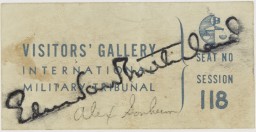
Artifact
Browse an alphabetical list of artifacts from the Holocaust and World War II. Each object tells a story about the history and demonstrates human experiences during the time period.
<< Previous | Displaying results 211-220 of 231 for "Artifact" | Next >>
-
The Times, August 17, 1921
ArtifactIn this London Times article, reporter Philip Graves compared passages from Maurice Joly’s Dialogue in Hell Between Machiavelli and Montesquieu (1864) side-by-side with the Protocols of the Elders of Zion in order to prove that the Protocols was plagiarized. Other investigations revealed that one chapter of a Prussian novel, Hermann Goedsche’s Biarritz (1868), also “inspired” the Protocols. Times (London), August 17, 1921.
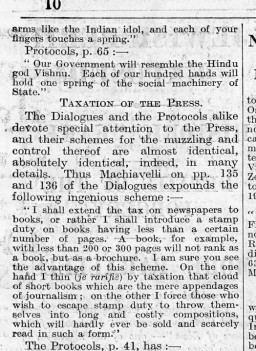
-
The Times, August 17, 1921
ArtifactIn this London Times article, reporter Philip Graves compared passages from Maurice Joly’s Dialogue in Hell Between Machiavelli and Montesquieu (1864) side-by-side with the Protocols of the Elders of Zion in order to prove that the Protocols was plagiarized. Other investigations revealed that one chapter of a Prussian novel, Hermann Goedsche’s Biarritz (1868), also “inspired” the Protocols. Times (London), August 17, 1921.

-
Three metal boxes used to hold content of the Oneg Shabbat archive
ArtifactThree of the ten metal boxes in which portions of the Oneg Shabbat archive were hidden and buried in the Warsaw ghetto. The boxes are currently in the possession of the Jewish Historical Institute in Warsaw. In this view the three boxes are stacked on top of one another. The box on top is displayed on its side without the lid.
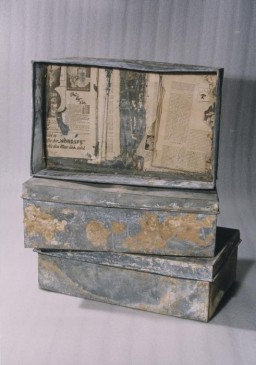
-
Tourist guide to Kobe, Japan (cover)
ArtifactThe Kobe Municipal Office issued this English-language tourist guide to Kobe and its environs. Jewish refugees in Kobe used such pieces of information. Kobe, Japan, 1940-1941. [From the USHMM special exhibition Flight and Rescue.]

-
Tourist pamphlet about Kobe, Japan
ArtifactThe Municipal Tourist Office in Kobe issued this folded English-language tourist guide to the city. One side shows photographs and descriptions of Kobe's historic and scenic sites and the other provides a tourist map of Kobe. Jewish refugees in Kobe used such pieces of information. Kobe, Japan, 1940-1941. [From the USHMM special exhibition Flight and Rescue.]
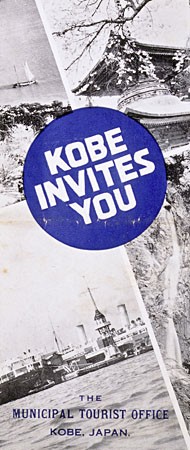
-
Trans-Siberian Express brochure (cover)
ArtifactFront cover of a brochure from the Soviet travel agency Intourist, describing the amenities of the Trans-Siberian Express. Despite their anxieties, most of the Jewish refugees traveling on the train felt like tourists. [From the USHMM special exhibition Flight and Rescue.]
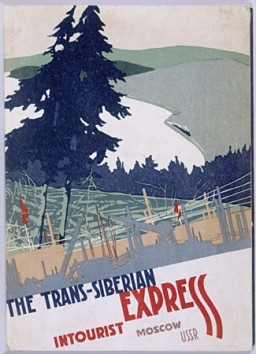
-
Travel Clock
ArtifactA seven-day gold traveling clock in a leather case, manufactured in France and originally made for a Russian nobleman. The panel in the leather case slides open to reveal the clock face. The clock was a Szepsenwol family heirloom. It was acquired by Chaya Szepsenwol's grandfather, who like her father, was a jeweler. The clock was among the family valuables that Rikla Szepsenwol was able to take out of Poland. [From the USHMM special exhibition Flight and Rescue.]
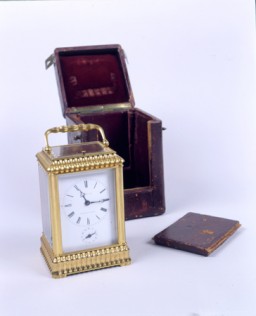
-
Unitarian Service Committee brochure
ArtifactBrochure published by the Unitarian Service Committee describing its relief mission in Nazi-occupied Europe.
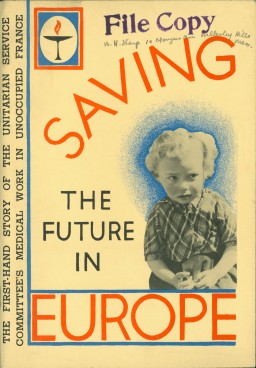
-
Valises by the railcar in the Museum's Permanent Exhibition
ArtifactMany different kinds of railway cars were used for deportations. They varied in size and weight. The railway car on display in the United States Holocaust Memorial Museum's Permanent Exhibition is of just one type used. The dimensions of the railway car in the Museum's exhibition are as follows: Total length 31 feet 6 inches (9.6 meters); interior space for deportees 26 feet 2 inches (8 meters). Total height 14 feet (4.3 meters) from the bottom of the wheel to the highest point of the car; interior space…

-
Visitor pass
ArtifactPass for the visitors' gallery at the International Military Tribunal at Nuremberg. Such passes were often shared among several people as they took turns observing the historic legal proceedings.
